Interpretation | "Insight" first explored the interior of Mars, just like the first "physical examination" in 4.5 billion years.
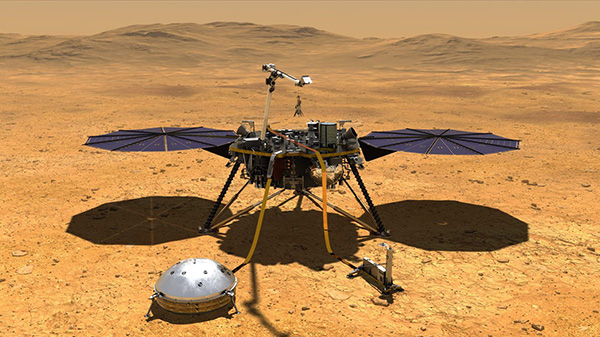
Insight probe
The researchers in dark red coats stared nervously at the big screen, and their faces showed eager anticipation for success.
"400 meters, 300 meters, 200 meters, 80 meters above the ground …" At the moment when Lu successfully sent back the beep (indicating that the probe was still "alive and healthy"), the researchers at NASA’s command center cheered, hugged and applauded … in different ways to celebrate the successful landing of human beings on Mars again after a lapse of six years-this human concern and exploration for nearly 60 years.
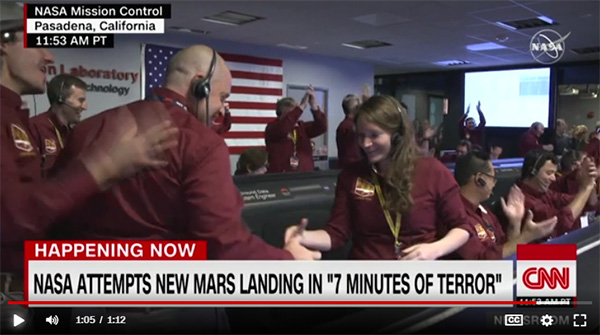
Command Center researchers celebrate the successful landing of Insight on Mars.
"Today, we have successfully landed on Mars for the eighth time in human history. We will send astronauts to the moon, and then send astronauts to Mars. Insight will provide valuable scientific information before we go to Mars. " Jim Breeden, director of NASA, said excitedly after the successful landing.
According to NASA news, the Mars probe Insight successfully landed on Mars at 14: 52: 59 EST on November 26th (3: 52: 59 Beijing time on the 27th). This is the first time that a human-made probe has successfully landed on the surface of Mars since the "Curious" rover successfully landed on Mars on August 5, 2012.
"There are drums underground, and we need to study the interior of Mars."
When it comes to the Mars exploration project in the United States, many people will think of rover vehicles such as Opportunity and Curiosity, which frequently appear in the media in recent years. In particular, Opportunity, which has a design life of only three months, stayed on Mars for 11 years, not only achieved fruitful exploration results, but also "accidentally" created a world record on Mars-ran more than 40 kilometers and completed a Mars marathon.
Since the launch of Mariner 4 Mars probe in 1964, the United States has been exploring Mars for more than 40 years, and obtained a lot of exploration results. As the country that has gained the most from Mars exploration, the United States is still non-stop in Mars exploration.
Pang Zhihao, an aerospace expert, told The Paper (www.thepaper.cn) that although it has been decades since humans first explored Mars, we still know very little about its internal structure. A total of 47 previous Mars explorations were conducted to study the global, surface, atmosphere and magnetic field of Mars. Insight will detect the interior of Mars for the first time, which is equivalent to the "first physical examination in 4.5 billion years" on Mars by CT scanning.
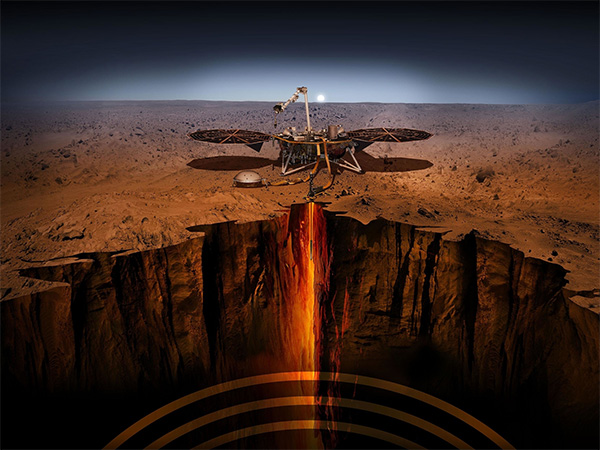
Insight will carry out the first human mission to explore the interior of Mars.
The old saying "knowing people’s faces but not their hearts" is also applicable to the field of deep space exploration. If we only know the ground and atmosphere of a planet, we will only know its surface, but we will not know its "heart". Yang Yuguang, vice chairman of the Space Transportation Committee of the International Astronautical Federation, told The Paper earlier: "It is impossible to know the interior of a certain performance by sending several probes around the planet orbit or on the ground. For example, the Kepler 452b exoplanet, which was a big hit in 2015, is similar in size and size to the Earth, but it is still impossible to know whether it is a rocky planet, let alone its internal structure. Therefore, to fully understand a planet, it is necessary to detect the internal structure of the planet. "
According to the information previously released by NASA, Insight mainly undertakes two major scientific tasks: First, by detecting the scale, frequency and geographical distribution of fire and earthquake activities inside Mars, and the frequency of meteorites hitting the surface of Mars, the current level of geological tectonic activities on Mars is determined; The second is to study the formation and evolution of terrestrial planets by investigating the internal structure and activity process of Mars. according to
According to the task, the researchers have formulated six investigation items: determining the size, composition and physical state of the Martian core; Determine the thickness and structure of the crust of Mars; Determine the composition and structure of the Martian mantle; Determine the thermal state inside Mars; Measure the amplitude, velocity and geographical distribution of fire and earthquake activity in Mars; Measure the impact rate of meteorites on the surface of Mars.
Bruce Bennett, the main person in charge of Insight, once told Nature that although Mars exploration has a long history, at most it left some scratches on the surface of the planet. "For 35 years, drums have been coming from underground, and we need to study the inside of Mars." Bruce Bennett said.
"Deepen the understanding of the earth’s’ neighbors’"
"Insight" was successfully launched on May 5 this year. After liftoff, it flew 485 million kilometers, which lasted more than six months. Insight is inextricably linked with the Phoenix lander that landed on Mars in 2008, so some media also called Insight Phoenix 2.0. Insight uses the platform of Phoenix detector, so it is very similar to Phoenix detector in appearance, but it has been partially adjusted according to different tasks. "Insight" is about 5.5 meters long, about the same size as a car, with a mass of 350 kilograms. In addition, there are two circular solar panels that can be unfolded like paper fans to provide power.
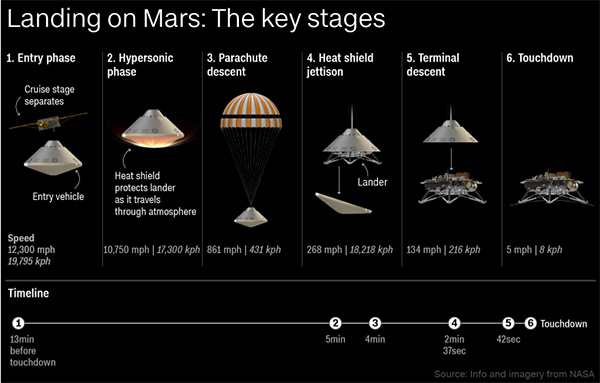
Steps to successfully land on Mars
"The previous Phoenix landed in the Arctic Plain of Mars, and obtained many detection results related to freezing, water and frozen soil in the Arctic Plain, and also found water in the soil. After heating, it was found that the soil contained more than 5% water, and dew was also formed on the landing leg, and the characteristics of water were discovered. " Yongchun Zheng, a researcher at the National Astronomical Observatory of Chinese Academy of Sciences and a planetary expert, said.
According to previous reports from American media, it took four years to choose the location of its landing site, and finally the specific landing coordinates were: 4.5 north latitude and 135.0 east longitude. Because the terrain here is flat, there are no gullies, and there is plenty of sunshine, which can charge solar panels. In addition, the landing site is 600 kilometers away from the "Curious" rover, and it can communicate with five mars orbiter mission currently in operation. In order to have a thick enough atmosphere to ensure the buffering needs of parachutes during landing, the landing point should be 2.5 kilometers below the Martian geoid, the terrain slope should be less than 15, there should not be too many rocks, and the weathered layer is soft, which is convenient for landing and drilling holes with a depth of 5 meters.
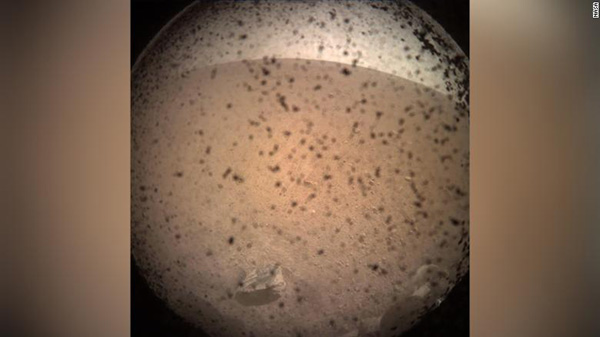
The first photo sent back by Insight
"Since 1965, we have studied Mars from orbit and surface, and learned about its weather, atmosphere, geology and surface chemistry," said Lori Glaze, acting director of the Planetary Science Department of NASA’s Science Mission Bureau. "Now, as NASA prepares to send human explorers deeper into the solar system, we will eventually explore the interior of Mars and deepen our understanding of the earth’s neighbors."
In order to deepen the understanding of the earth’s neighbors, Insight will carry three completely different scientific payloads, including two instruments provided by Europe, specially designed to explore the deep core of this red planet. Including seismograph equipment, geothermal flow value detector and "rotation and internal structure test" detection equipment. Among them, seismograph equipment and geothermal flow detector were developed by France and Germany respectively. In addition to the above three detection devices, two cameras are also equipped, which can measure the pressure, temperature and wind speed of Mars for noise correction of seismograph data. Of course, these data will also be useful materials for Martian weather research.
"Use a seismograph to detect the seismic waves inside. Some earthquakes inside Mars are natural earthquakes, others are earthquakes caused by internal activities of Mars, and some asteroids and meteorites will hit Mars and cause certain vibrations." Yongchun Zheng said, "The propagation of seismic waves will reflect the signal. According to the interpretation of the signal, we can get the data of the internal structure and composition of Mars. Is it divided into crust, mantle and core like the earth? Where are the dividing lines, the thickness of the crust, and whether there are mantle and other issues."
"Earthquake is a very important instrument for us to understand the interior of the earth, Mars and the moon." Yongchun Zheng added.
The heat flow detector mainly measures the temperature and gradient at a certain depth on the surface of Mars. By measuring the temperature gradient of the material and multiplying the thermal conductivity of the material, we can calculate the heat flow and the heat transferred from the inside per unit area per unit time. According to the combination of this heat and seismic wave data, we can infer the heat release inside Mars.
According to relevant data, measuring heat flux can understand the release of internal energy, which is realized by the decay of internal radioactive elements, thus inferring the current internal heat of Mars. The initial situation of the formation of Mars can be inferred by a model, such as how many radioactive elements were contained at that time, and how much heat is contained in Mars now. Second, this issue is related to the history of internal thermal evolution and the stratification of internal structure of Mars.
In short, the seismograph is used to detect the stratification of the internal structure of Mars, while the heat flow meter is used to detect the thermal evolution history of Mars.
"Another example of international cooperation in deep space exploration"
Insight is an international cooperative deep space exploration project. "This achievement represents the wisdom of the United States and our international partners, and also proves the dedication and perseverance of our team." Jim Breeden Stern, director of NASA, pointed out. CNN reported that after the successful landing of Insight, US Vice President Burns called to congratulate the whole team.
On the "Insight" detector, the seismograph was developed by France and the heat flow detector was developed by Germany, and these two are two of the three most important instruments of the detector.
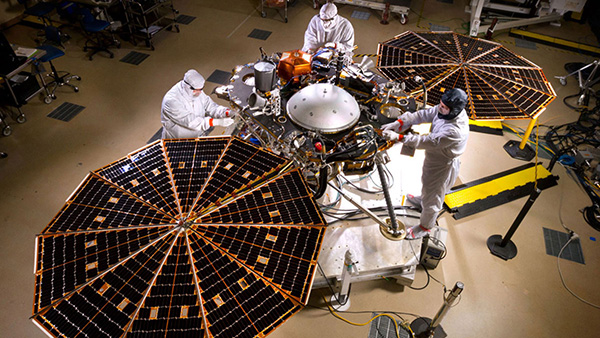
"Insight" in the test
"The successful landing on Mars laid the foundation for future exploration. If the project is successfully completed, Insight will become another example of international cooperation in deep space exploration." Pang zhihao believes.
It is worth mentioning that the "Insight" mission will also deploy two microsatellites to tentatively provide real-time relay signals to the Earth during the landing phase. This is also the first time that "interstellar microsatellite" has been used in deep space missions.
The two microsatellites used in Insight mission are called "Mars Cube One", and they will be launched together with Insight and embark on a journey to Mars. When Insight lands on Mars, they will fly by Mars and transmit the landing data of Insight to the earth relay satellite. According to NASA, "Mars Cube One" is like the relay satellite of Insight landing probe, which can greatly improve the signal transmission efficiency of Insight. If the experimental mission is successful, future microsatellites will be applied to more interstellar missions to explore the solar system.
"Mars Cube One" is only a pilot project, so the communication relay can’t count on these two brothers. Yang Yuguang said: "As the relay mission of Insight, the Mars Reconnaissance Orbiter has adjusted its orbit to meet the coming Insight in 2016. It can help Insight to correct its orbit, provide an accurate descending orbit for Insight, and will personally witness the process of Insight entering the Martian atmosphere and landing, and store and record data. Once the’ Insight’ reaches the surface of Mars, the reconnaissance orbiter will serve as a relay communication task. "